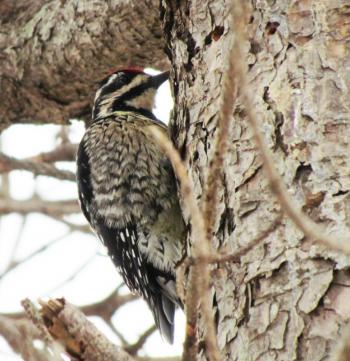Catbirds and Sapsuckers Becoming Maine Winter Birds?
Many’s the person who has been unhappily awakened at dawn on a spring or summer day by the raspy, mewing catlike call of the gray catbird. Not too far behind in numbers are those people, often while enjoying the peace and solitude of a May morning at the camp by the lake, who have leaped out of bed at daybreak to the loud “rat-a-tat-tat-tat-tat” of an exuberant male yellow-bellied sapsucker drumming on the stove pipe.
Gray catbirds and yellow-bellied sapsuckers are birds we expect to see and hear in spring, summer, and fall here in Maine —not in winter.
But increasingly, and especially this year, more and more sightings of both species are occurring here in Maine in the winter months.
Gray catbirds migrate in winter as far south as the Caribbean and Central America—there is even at least one photographically documented record for Colombia in South America and a possible record from Bonaire! A few winter along the coasts of southern New England and the Mid-Atlantic States, and they are pretty common in winter in Florida and the other Gulf states. Yellow-bellied sapsuckers have almost the same winter distribution including even a couple of records from Colombia and one from Aruba.
Given that track record, it was a surprise that at least 10 sapsuckers and 16 catbirds have been sighted so far in Maine this year in December and January. One of the catbird sightings was out on Matinicus Island where one of us (Jeff) did the Christmas Bird Count with a few other hardy souls on January 3rd. (Let’s hope it, and the others around the state, made it through the storm that hit the next day.) Last year in the same two months, eBird shows only three catbird and two sapsucker sightings. And if you go back a bit further, in the 10-year span between 1999 and 2008, there was only a single sapsucker record and two catbird records in the December to January period, according to eBird.
Perhaps yellow-bellied sapsucker and gray catbird are soon to be added to Maine’s list of birds that are regular winterers (at least in relatively small numbers) like song sparrows, yellow-rumped warblers, northern flickers, and hermit thrushes. Turkey vultures have been added to that list now in the last 10-15 years, and one was even seen as far north as Houlton in December this year. A black-and-white warbler was found on the Mount Desert Island Christmas Bird Count this year but this is not a species that we expect to become more regular in winter since few of them normally winter north of the Carolinas. Neither are painted buntings, despite the fact that one was found on the Portland Christmas Bird Count in December. Some of you may remember the painted bunting that wintered at an Ocean Point feeder a few years back.
Birders are documenting the changes that are happening as the pace of climate change impacts hastens here on Planet Earth. Though it is interesting to witness some of the changes in bird distribution, our planet will be much better served by policies implemented by forward-thinking leaders wherever they may be, to slow climate-change.
Jeffrey V. Wells, Ph.D., is a Fellow of the Cornell Lab of Ornithology. Dr. Wells is one of the nation's leading bird experts and conservation biologists and author of “Birder’s Conservation Handbook”. His grandfather, the late John Chase, was a columnist for the Boothbay Register for many years. Allison Childs Wells, formerly of the Cornell Lab of Ornithology, is a senior director at the Natural Resources Council of Maine, a nonprofit membership organization working statewide to protect the nature of Maine. Both are widely published natural history writers and are the authors of the book, “Maine’s Favorite Birds” and the newly published “Birds of Aruba, Bonaire, and Curaçao” from Cornell Press.






























